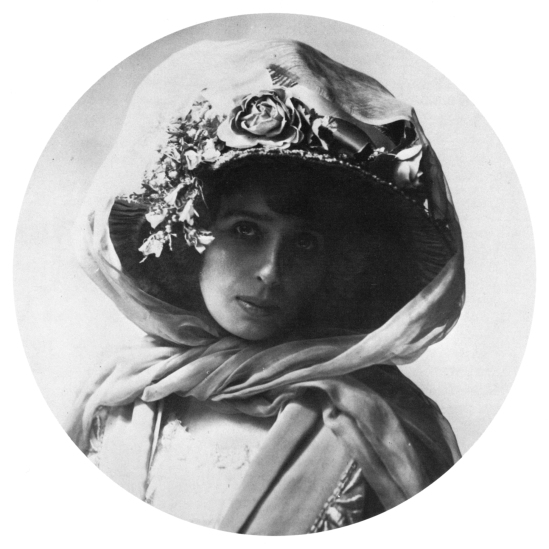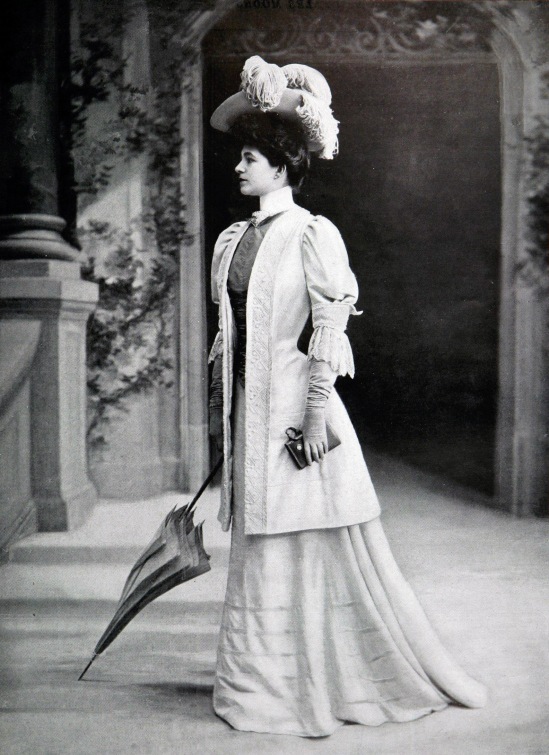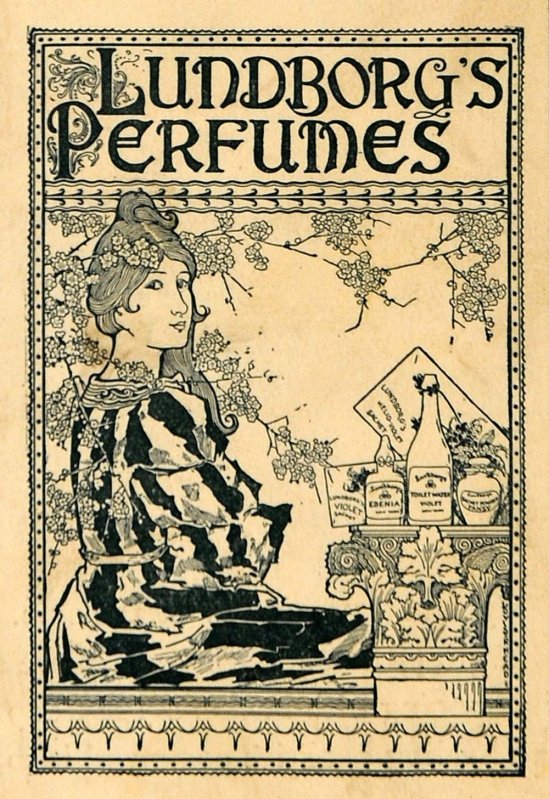
Mistinguett by Félix Nadar via


Mistinguett by Félix Nadar via

Otto Sarony, Portrait of Evelyn Nesbit, 1900s via

Tightlaced Gibson Girl, Camille Clifford, showing her ideal La Belle Époque figure via

Edwardian lady wearing Redfern, who among other things popularised high-waisted Grecian style dresses after 1908 via

Dress for the races by J. Dukes, photo by Reutlinger, Les Modes, May 1912 via

A fashionable woman at the races in 1909. Scanned from the book “The Mechanical Smile” by Caroline Evans via

Gorgeous Edwardian dresses, hats and parasols, 1906. Belle epoque fashion via

Actress Lily Elsie in an Ewdardian gown via

Raoul Dufy was one of the great innovators of 20th century textile design here is an example on velvet for a Paul Poiret cape 1911 via

Woman wearing French fashion. ca. 1905 via

Fashion, ca. 1914 via

Antique photo postcard of Edwardian beauty with a large hat and a snowfox stole around her shoulders via
Edwardian hairstyles were largely dictated by the millinery trade. The hairstyles had a soft, fluffy and loose fluidity about them. Hair was dressed off the face, with the exception of a fringe, and hairstyles rarely had a parting.
The defining Edwardian hairstyle for women was the pompadour. After the Pompadour´s initial popularity among fashionable women in the 18th century, it was revived as part of the Gibson Girl look in the 1890s and continued to be in vogue until World War I.
Other hairstyles were fx. the Low Pompadour (for everyday), Hat Pin Hairstyles (for the late Edwardian Cartwheel hat), the Gibson Tuck, the Side-Swirl (the style allowed women to easier wear the picture hats), the bouffant and the chignon. Usually the full Pompadour hairstyle was kept for special occasions. In the early part of the Edwardian era it was accompanied by the “picture” hat; hats that were worn high on the head and heavily decorated with fabric, feathers or imitation flowers or fruit.
The Pompadour hairstyle could be dressed in all manner of styles, but the basic concept is hair swept upwards from the face and worn high over the forehead, and sometimes upswept around the sides and back as well. The style could feature soft coils and fuzzy curled fringes. It could be decorated with a bun, chignon or knot, depending on what was in vogue at the time and the occasion. Chignons tended to sit low on the nape, or at the back of the head. A bun could also be situated on the crown. A knot is hair that is twisted to form a rope, and then coiled to form a shape. The different shapes had names, for example the Apollo Kno, the Psyche Knot and the Grecian Knot. A topknot sits high on the head.

Evelyn Nesbit, who posed for illustrator Charles Dana Gibson, and became known as the first “Gibson Girl.” Gibson’s drawings of women represented the feminin ideal of the time via
The Soft Pompadour and Psyche Knot. From Girls Own Paper and Woman’s magazine, 1911 via

Gibson Girls with Pompadour hair via

After the Victorian era hair got bigger and bigger via

Actress Gabrielle Ray´s hairstyle fits her large decorated hat, 1906 via

Edwardian lady with big frizzy hair via
Miss Ethel Oliver with big Edwardian hair via

Nancy Astor with a knot, 1908 via
Charles Frederick Worth (1826-1895) is widely considered the Father of Haute Couture. He dominated Parisian fashion in the latter half of the nineteenth century.
He completely revolutionised the business of dressmaking. He was the first of the couturiers, dressmakers considered artists rather than mere artisans.
Much of his work is associated with the movement to redefine the female fashionable shape, removing excessive ruffles and frills and using rich fabrics in simple but flattering outlines. He is also credited as the first designer to put labels onto the clothing he manufactured.

Evening Dress, House of Worth ca. 1890

Afternoon jacket House of Worth

Evening dress, House of Worth 1902
Evening coat, House of Worth, 1902
Silk tea gown, House of Worth, 1900-1901

1888, House of Worth

Draping of blouses in Worth, Paris 1907.

An elegant woman at Worth’s studio in 1900
Lucy Christiana, Lady Duff-Gordon (née Sutherland) (1863 –1935) was best known by her professional name “Lucile”. Who was at the beginning of the twentieth century one of the most innovative, forward thinking designers. Much like her contemporary, Paul Poiret, she designed clothes for the modern woman. She launched liberating slit skirts and low necklines, popularized less restrictive corsets, and promoted alluring, pared-down lingerie.
She originated the “mannequin parade”, a precursor to the modern fashion show, and trained the first professional models who were almost as famous as she was. She gave them poetic names, like Hebe, Corisande and Dolores.
She opened branches of her London house, Lucile Ltd, in Paris, New York City and Chicago, dressing a trend-setting clientele of royalty, nobility, and stage and film personalities. Some well-known clients, whose clothing influenced many when it appeared in early films, on stage, and in the press, included: Irene Castle, Lily Elsie,Gertie Millar, Gaby Deslys, Billie Burke, and Mary Pickford.
Lucile costumed many theatrical productions including the London première of Franz Lehár’s operetta The Merry Widow (1907), the Ziegfeld Follies revues on Broadway (1915–21), and the D. W. Griffith silent movie Way Down East (1920). Her fashions were also frequently featured in Pathé and Gaumont newsreels of the 1910s and 20s, and she appeared in her own weekly spot in the British newsreel “Around the Town” (c. 1917–1919)
Lucy Duff Gordon is also remembered as a survivor of the sinking of Titanic in 1912.

Lady Lucy Duff Gordon with her dogs by Marceau via

Lily Elsie in The Merry Widow, 1909, costume by Lucile via

Lily Elsie, shown here in a costume designed by Gordon for a 1909 play called “The Dollar Princess.” via

A model in a dress by Lucile (Lady Duff Gordon), ca. 1912 via

1921 Lucile evening gown of a black chantilly lace hoop over a white satin slip, shown at the National Retail Garment Association Fashion Show at the Hotel Commodore, NYC via

“Toilette en « Burlingham silk», créée par Redfern pour Mlle Camille Preyle, du théâtre du Vaudeville. Robe d’après-midi ; longue jaquette avec revers brodés ; gilet de taffetas parme brodé or, col et cravate en véritable dentelle.” Photograph in Les Modes : Revue mensuelle illustrée des arts décoratifs appliqués à la femme via

“Robe en batiste Pompadour. Volants de valenciennes, col brodé, perles vieux ton.” Photograph in Les Modes : Revue mensuelle illustrée des arts décoratifs appliqués à la femme via

” Mlle De Léka. Grande jaquette en drap brique. Jupe princesse en drap blanc.” Photograph in Les Modes : Revue mensuelle illustrée des arts décoratifs appliqués à la femme via

Charles Dana Gibson, Woman in black evening dress, 1901 via

Luce’s Eau de Cologne via

black and white print ad for Linden Bloom Perfume, a product by Foote and Jenks in Jackson, Michigan, 1893 via

Giraud Fils, Eau de rose via

Delettrez, Perfumes and Toilet Soaps via

Ad Murray & Lanman’s Florida Water Perfume Cologne Fairies Art Nouveau YSN2, 1900 via

Ad Ed Pinaud Perfume Foscarina Unique Glass Bottle Fragrance Scents MX7, 1902 via
Lundborg’s Perfumery was founded in 1850 by a Swedish immigrant, John Marlie Lundborg who came to the United States and settled in Hudson, New Jersey. He left Sweden early in life and was a reported to be a fine botanist and chemist, who had a great love for flowers, and “possessed a peculiar gift duplicating their perfume”. Concocting perfume was not only a hobby, but proved to be lucrative and was turned into a business.
He sold an interest in his business to Richard D. Young in 1872 who purchased the recipes, trademarks, and good will from their inventor. By 1873, the company was renamed Young, Ladd & Coffin (source)

Ad Vio-Violet Lundborg Perfume Ladd & Coffin NYC, 1895 via

Ad Lundborgs Perfume Ladd & Coffin 24 Barclay St, 1895 via